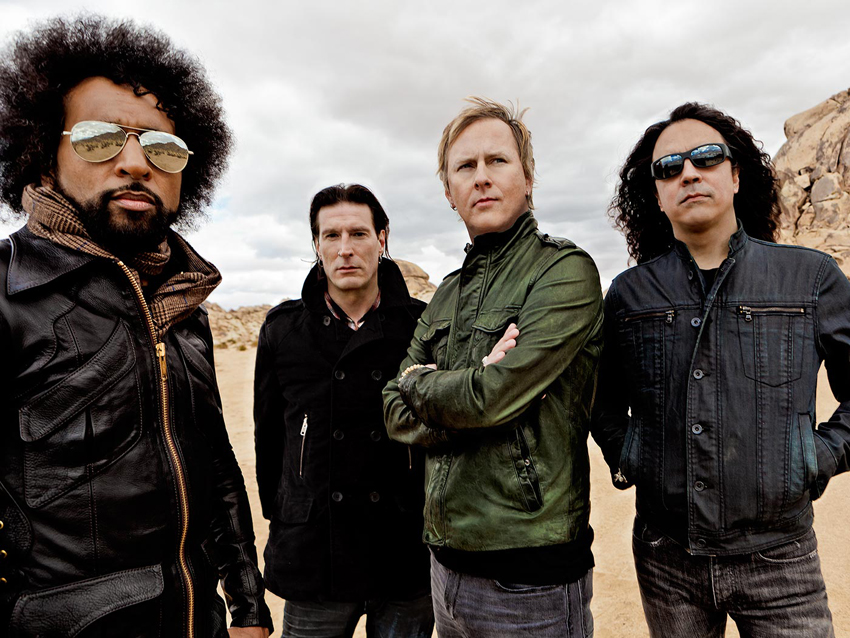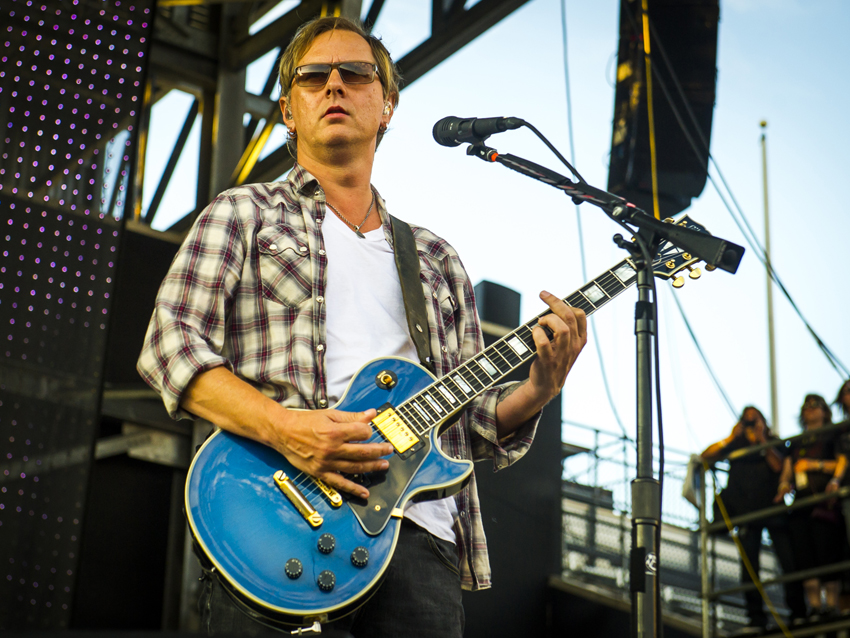
A lot of people are talking about the subject matter of the title track to Alice In Chains' forthcoming album, The Devil Put Dinosaurs Here (due out 28 May). The song deals with intolerance and the willingness of those who reject facts for political purposes. The band's guitarist and co-vocalist, Jerry Cantrell, is surprised to discover that some are surprised at all. To him, the group has never shied away from writing music with a message.
"It blows me away," Cantrell says. "Those two words: 'social commentary.' It seems as though everybody's flipped out that we have something to say. We've been saying shit all along. It's not a subject we haven't written about before, although we never had the Devil going around the Earth putting dinosaur bones in our lyrics. That's a new one, I guess."
Clarifying the notion that the lyrics are, in some ways, an attack on religion, Cantrell explains that the band is simply "saying something about blind hate - teaching stupid shit that doesn't equal up to fact. There's a lot of good truths to be learned in any belief system. It's the human application that makes it go fucking wrong."
One thing that can't be disputed is that the classic Alice In Chains sound, which the band upheld on 2009's Black Gives Way To Blue, its first with vocalist William DuVall, remains as biting and compelling as ever on the new set. Cantrell's mix of pulverizing electric guitars, contrasted on a trio of songs with a neon-rainbow-like blend of acoustics and electrics, is the engine that drives the band's rapturous aesthetic.
Cantrell talked to MusicRadar recently about how he constructs the Alice In Chains guitar sonic structure, his artful use of the wah pedal, what producer and eternal fanboy Nick Raskulinecz brings to the table and how departed members Layne Staley and Mike Starr live on through the band's music.
I have to imagine there's a discovery process that is the result of making any record. What do you think you might have learned about yourself, or even the band, when making this album?
"You're right - every record is like that. It's kind of similar to lots of elements to this job: You get together and play shitty clubs, and you're working for years before you finally become an overnight success. [Laughs] There's so much shit that happens before anybody even knows about you. It's massive amounts of time, months and months of demoing; putting gear together and sharing stuff; pulling everything apart, learning how to play - it's a lot. Then there's the actual recording, mixing, the packaging. By the time you all get the music, we're already done with it and thinking about something else.
Want all the hottest music and gear news, reviews, deals, features and more, direct to your inbox? Sign up here.
"I respect the process because I know how hard it is. As individual musicians and as a band, it's something we care about a great deal, because it's all about the journey. Each record is like a chapter of a book or a time capsule - not just the music but also the collective lives. We're in a different place, and this is a different record, but it's similar; it's recorded for posterity and shared with everybody. Part of it will remain private, and it's what nobody will ever know [laughs]. And that's meaningful. And a lot of it is there for you to listen to and decipher and pick through."
The overall sound of the band has never been monochromatic - there's always been a "beauty and the beast" aspect to the contrasting sonics. Where did that come from?
"There's a lot of influences to the band. One of the elements is the power and heaviness and kind of a darkness, but there's always melody and beauty mixed in with that. Personally, I grew up listening to everything from country to pop to soul to rock - you name it. I would say that the other guys have similar influences, as well.
"I had a healthy dose of choir in high school. We got to do a lot of classical music, which has a lot of dark elements to it. I think all of those influences stuck, and they shine through in what we do."

Alice In Chains, 2013 (from left) William DuVall, Sean Kinney, Cantrell and Mike Inez © Johnny Buzzerio
It's always good when band members come from different musical places. If everybody in a band loves only AC/DC, they're probably going to sound like a bad imitation of AC/DC.
[Laughs] "That's a great point. I mean, you have to start from somewhere. AC/DC is one of my favorite bands and one of my biggest influences for doing what I do. We don't sound like them because we're not those guys; only those guys can sound that way. You can pick many bands that tried to sound like them - like Krokus, you know? There were a couple of Krokus tunes that I was sure were AC/DC inspired.
"Nobody can do it like them, and that's the goal. The goal is to try to find your voice. You begin by emulating your heroes - those guys are one of many - and then you find out who you are; then who you are is what you become to them - a signpost, maybe a direction to go in before they find their voice. Or maybe some signposts which way not to go." [Laughs]
I'm curious about your use of the wah pedal. To me, you've never used it as mere color - it's always been a real part of your vocabulary.
"It is, absolutely. From the very beginning, that's the one I fell in love with. It gives a guitar a voice; it makes it speak. I've always admired guys who incorporated that heavily into their sound. So it was and remains the one effect that I use the most. I also liked the way it changes a guitar's tone; when you have it on and it's sort of held wide-open, it makes the sound squashed and dark."
What was the evolution of your use of the wah? Was it a lot of trial-and-error? Did you incorporate it into your sound very naturally?
"It was just a lot of time spent, you know? That's really what it was. You have to have a guitar in your hand, and you have to spend a lot of time doing it. From the moment I first had a really decent guitar, it remained in my hands constantly. Throughout my life, it's been the number one thing to me. And it's remained the most constant thing in my life; it's been my longest commitment. You would hope that the time spent would mean that you're growing and getting better."
This is your second album with Nick Raskulinecz. What does he bring to the band's music that you feel is noteworthy?
"There's a couple of key elements: The first thing is that he never stopped being a fan of music; he loves it; he really loves it. He's in your face with a drumstick around, fake singing while you're doing tracks - it's a little ridiculous at times. [Laughs] I'll be like, 'Dude, chill out!' And he'll go, 'Fuck it, man. It's killer!' He's so into it.
"And two: He's a player. He's a rocker; he has the player's element. He plays drums, bass - he has knowledge of the instruments. He has insight into what you're capable of getting and when you can do more. The sign of a great producer is somebody who makes a band sound the best that they possibly can, not somebody who puts their stamp on the band. 'I'm so-and-so, and this is my sound; this is how we're gonna do it' - that's not a good producer to me.
"But there's producers who are like that. They have a formula; they have a sound; they'll work with multiple bands, and you'll pretty much hear the same sound on all the records. With Nick, whether he's working with the Foo Fighters or Rush or the Deftones or us, each band sounds like them."
The riff for the song Hollow could probably be played a number of different ways, and it would still sound cool. Did you work out the phrasing over time, or was it immediate?
"That one was pretty immediate. It came about on the last night of the Black Diamond Skye tour we did, our headlining run with the Deftones and Mastodon. It was the very last show, we were in Vegas and I was sick as hell - I was about a click above pneumonia. But I was warming up in my dressing room, and I started playing that riff.
"Right away, I knew it was a good one to store away for later, so I recorded it. Nick happened to be at that show, and so were my managers. Everybody perked up when they heard me playing it. 'What's that? That's pretty good!' [Laughs] I was like, 'Yeah, it is.' So I tucked it away. It was pretty immediate the way it came to me."
Songs such as Voices, Choke and Scalpel feature that gorgeous blend of acoustics and electrics that has been such an identifiable part of the Alice In Chains sound. Do you have any go-to acoustics for recording?
"It's kind of whatever works. There's a handful of guitars that gets used over and over. For years I've borrowed acoustic guitars from Nancy Wilson because she's got one of the best collections there is. There's a Hummingbird that I've used on a couple of records - I used that again. At Henson Studios, I borrowed some guitars from John Shanks - a couple of old Gibsons and an old Martin. There's a Guild on the record and some 12-strings…
"The way I look at it is, you don't know what you need until you go in and start doing the job. Then the song starts telling you what needs to be there. It's a bit of trial and error. You start playing the guitar - or, if you want to take it a step further to the electric side, a guitar-and-amp combo - and pretty quickly you can figure out if it's going to work or not."

When recording guitars in the studio, Cantrell says, "Things have to be set up right, and I've got to play tight as hell." © Â Chris Schwegler/Retna Ltd./Corbis
With your all-electric sound in particular, there's a great wall of power, but it's never muddy - each note rings through and is articulated.
"Taking it from my end, certain things happen in the studio where you'll come up with a part that sits on top of something else real nice. Generally, I have a good portion of my stuff laid out beforehand - what the rhythm track is, if there's a color line between that; I have a knowledge of the parts.
"Now, how to record those parts and make them a reality, that's where Nick and Paul Figueroa, our engineer, and I sit down and work as a team. Things have to be set up right, and I've got to play tight as hell. But that's always been one of my strengths - playing to myself and playing extremely tight. That probably comes from all the time I've spent demoing over the years.
"With any track, you might be hearing anywhere from two to five different cabinets with different amp heads running at the same time. We had a stack of amps: a Marshall; my Dave Friedman amps, which I've been using for the last couple of years; we had Bogners hooked up; we had an Orange head; a Laney Clip; a Hiwatt; and we had an AC30 for all of those songs you mentioned that are a mix of acoustics and electrics.
"When you stack all of that up, you have to make sure that everything is in phase, and you have to make sure that each guitar is intonated and in tune. That's a time-consuming process. I think people would be amazed at how long it takes to do a lot of stuff that's pretty tedious. But we're willing to go through the process; you don't want to leave any nail unhammered."
And then there's the band's vocals, that special blend that was you and Layne and now you and William. Where did that come from? Growing up, were you a fan of great vocal groups like Crosby, Stills & Nash and the Eagles?
"Absolutely. The Who, The Beatles - there's a ton of bands that had two voices. Roger Waters and David Gilmour, and before them there was Syd Barret. I've always been a fan of bands that had multiple voices. The Cars were another one. You can pick out individuals on certain songs, but on others it's like they're one voice. That's the trip; it's kind of the thing we created.
"I have to give all credit to Layne. From the first time I heard him sing, I knew that I wanted to be in a band with him. I always thought that he was the most amazing vocalist I'd ever heard, and I still think that. He would take whatever I gave him and make it so much better. And vice versa: He would write, later on with guitar and stuff, and I would help him, too. I started out as a backup singer, and then I started singing leads. Probably on Sap is when I started singing leads.
"That continued to grow, and now that's what this band is based on. I needed, and the band needed, a partner, and I've been very fortunate to continue that legacy without shitting on it. William has been a big part of that and has come along with how we work, getting to know how to do that.
"[Drummer] Sean [Kinney] and I have been here all along, so we know how this thing goes. And [bassist] Mike [Inez] has been here a long time, too. We know how this band is supposed to sound. I just think that there's a collective body or a consciousness. Layne and Mike Starr are a part of that. I like to think that they still have a voice through us."
Joe is a freelance journalist who has, over the past few decades, interviewed hundreds of guitarists for Guitar World, Guitar Player, MusicRadar and Classic Rock. He is also a former editor of Guitar World, contributing writer for Guitar Aficionado and VP of A&R for Island Records. He’s an enthusiastic guitarist, but he’s nowhere near the likes of the people he interviews. Surprisingly, his skills are more suited to the drums. If you need a drummer for your Beatles tribute band, look him up.
